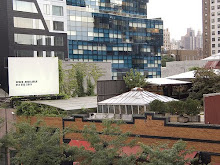


1) Picture of where Seneca Village existed in the Park, 2009. 2) A plaque that provides a brief history of Seneca Village's existence, 2009. 3) An Interpreted illustration of Seneca Village, 1856. (Columbia University Seneca Village Project).
Between 81st and 89th St between 7th and 8th Ave,
Central Park West, New York, NY
Location of the Plaque: 85 St and Central Park West
Directions: From Midtown New York, Head northeast on Central Park Driveway toward East Dr, Continue onto East Dr, Turn left at 72nd St Transverse/East Dr, Continue to follow 72nd St Transverse, Turn right at Central Park Driveway,Turn left at W 77th St, Take the 1st right onto Central Park West. (Google Map)
Central Park is a major attraction for city dwellers, tourists, and the affluent communities in Upper Manhattan as a recreational site. However, majority of the population are unaware of history of Central Park, which contradicts and juxtaposes its position chronically. The creation and subsistence of Central Park marks a history of injustice by institutions with racialization of property and ownership rights. Before the much-publicized landscaped park was created, Seneca Village existed as settlement of African Americans, Irish, and German immigrants from 1825 to 1857 (Rosenzweig, and Blackmar, 67). The community was initially established in the 1820s by African Americans, who purchased land for their homes. There are different theories to how the African Americans gained access to land ownership. Nonetheless, their presence in the village is regarded as one of the first significant accounts of self-determination through landownership. The dominant premises for land accumulation are that property ownership was required for African Americans in order to qualify for the right to suffrage and vote after the New York State Constitution Act of 1821(Chambers, and Shackel,102). The other factors were that the land bordered out of the city was inexpensive and sustainable as a “free black settlement,” where the African Americans were less likely to be discriminated in the housing market. The other waves of residents could also have had right of entry through the African Union Church or other churches, who purchased land in Central Park (Rosenzweig, and Blackmar, 70).
In the 1840’s Irish and German immigrants integrated the village and ethnic mix lived harmoniously for a short period. The mixed community was regarded as a “little settlement” of vagabonds that lived with hogs and goats, despite its occupants of over 260 of which was two-third African American and one-third European (Shackel, and Chambers). The press at the time created a common sense ideology that racialized Seneca Village and its people by criminalizing and diminishing their presence (Germic, 35). They were generalized by hegemonic consensus to be useless criminals living in filthy huts as lower class citizens. The creation of “lower class” citizen also leads to concept of wealth gap to be constructed as a racial difference (Germic, 35).
Contrary to the popular misconceptions, Seneca Village’s residents co-existed as a resourceful and diverse community in relation to the other ethnic enclaves of the time (AG). The village had their own institutions that included three churches, its own burial ground, and schools. Most of the residents either owned or rented the property as opposed to the common sense of being “squatters.” Nonetheless, after many political disputes the city chose the village and the surrounding land as a site for Central Park. Soon after over 1500 residents on the land were evicted on the basis of eminent domain, which also signified that the occupants were treated as lower class citizens that could not contest to their removal (Chambers, and Shackel, 103). Although the property owners were compensated, it did not hinder the fact that they were displaced. Seneca Village is prime example of how the narrative of racial ideologies construct and wipe away historical imprints of institutional discrimination based on race, class, and status.
- Clare Delaney and Upahar Rana
Sources
Chambers, Erve, and Paul Shackler. Places in mind: Public Archaeology as Applied
Anthropology. Critical Perspectives in Identity, Memory & the Built Environment. New York: Routledge, 2004. Print.
Germic, A Stephen. American green: Class, Crisis, and the Deployment of Nature in Central
Park, Yosemite, and Yellowstone. Boston: Lexington, 2001. Print.
Rosenzweig, Roy, and Elizabeth Blackmar. The Park and the People: A History of Central Park.
New York: Cornell, 1992. Print.

City tourists love to visit central park in New York and enjoy there. Thanks for sharing this nice post! cheap park and fly deals
ReplyDelete